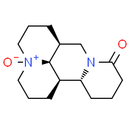Description
Oxymatrine is a protective agent against apoptosis, tumor and fibrotic tissue development, and inflammation.
Product information
CAS Number: 16837-52-8
Molecular Weight: 264.36
Formula: C15H24N2O2
Synonym:
Matrine N-oxide
Ammothamnine
Matrine oxide
Matrine 1beta-oxide
Chemical Name: (4R,41R,7aS,13aR,13bR)-10-oxododecahydro-1H,5H-dipyrido[2,1-f:3',2',1'-ij][1,6]naphthyridine 4(41H)-oxide
Smiles: [O-][N+]12CCC[C@H]3CN4[C@H](CCCC4=O)[C@@H](CCC1)[C@@H]23
InChiKey: XVPBINOPNYFXID-LHDUFFHYSA-N
InChi: InChI=1S/C15H24N2O2/c18-14-7-1-6-13-12-5-3-9-17(19)8-2-4-11(15(12)17)10-16(13)14/h11-13,15H,1-10H2/t11-,12+,13+,15-,17?/m0/s1
Technical Data
Appearance: Solid Power.
Purity: ≥98% (or refer to the Certificate of Analysis)
Solubility: Soluble in DMSO
Shipping Condition: Shipped under ambient temperature as non-hazardous chemical or refer to Certificate of Analysis
Storage Condition: Dry, dark and -20 oC for 1 year or refer to the Certificate of Analysis.
Shelf Life: ≥12 months if stored properly.
Stock Solution Storage: 0 - 4 oC for 1 month or refer to the Certificate of Analysis.
Drug Formulation: To be determined.
HS Tariff Code: 382200
How to use
In Vitro:
Oxymatrine, an alkaloid component extracted from the roots of Sophora species, has been shown to have antiinflammatory, antifibrosis, and antitumor effects and the ability to protect against myocardial damage, etc. The potential signaling pathways involved in the clinical application of oxymatrine might include the TGF-β/Smad, tolllike receptor 4/nuclear factor kappa-light-chain-enhancer of activated B cells, toll-like receptor9/TRAF6, Janus kinase/signal transduction and activator of transcription, phosphatidylinositol-3 kinase/Akt, delta-opioid receptorarrestinl-Bcl-2, CD40, epidermal growth factor receptor, nuclear factor erythroid-2-related factor 2/hemeoxygenase-1 signaling pathways, and dimethylarginine dimethylaminohydrolase/asymmetric dimethylarginine metabolism pathway. Oxymatrine significantly inhibits the proliferation of DU145 and PC-3 cell lines in a time- and dose-dependent manner. By contrast, following treatment with oxymatrine, PNT1B healthy human prostate cell proliferation is not inhibited.
In Vivo:
The volume and weight of tumors in mice significantly decreased in a dose-dependent manner. Oxymatrine may reduce prostate cancer cell growth by promoting cell apoptosis in vivo. Oxymatrine is effective in reducing the production and deposition of collagen in the liver tissue of experimental rats. Oxymatrine could promote the expression of Smad 7 and inhibit the expression of Smad 3 and CBP in CCl4-induced hepatic fibrosis in SD rats, could modulate the fibrogenic signal transduction of TGFβ-Smad pathway.
References:
- Parvez MK, Arbab AH, Al-Dosari MS, Al-Rehaily AJ. Antiviral Natural Products Against Chronic Hepatitis B: Recent Developments. Curr Pharm Des. 2016;22(3):286-93. Review. PubMed PMID: 26561057.
- Lu ML, Xiang XH, Xia SH. Potential Signaling Pathways Involved in the Clinical Application of Oxymatrine. Phytother Res. 2016 Jul;30(7):1104-12. doi: 10.1002/ptr.5632. Epub 2016 May 10. Review. PubMed PMID: 27165263.
- He M, Wu Y, Wang M, Chen W, Jiang J. Meta-analysis of the clinical value of oxymatrine on sustained virological response in chronic hepatitis B. Ann Hepatol. 2016 Jul-Aug;15(4):482-91. Review. PubMed PMID: 27236147.
Products are for research use only. Not for human use.
Payment & Security
Your payment information is processed securely. We do not store credit card details nor have access to your credit card information.


